How To Start and Run a Successful Print on Demand Business: Unlock The Right Product Niche!
Once you’ve decided to start a print-on-demand business there are several different things you’ll need to consider.
One of the most important decisions you’ll be making is your product niche. You need to break free from the oversaturated online retail market space and differentiate yourself from a sea of competitors. By picking a niche, you’re saying, “I offer something unique, something different, and something useful”. And it’s not as tedious as it seems- in fact, it can be quite entertaining to go through the process! So, how exactly do you do it? Let’s take a look…
Open Shopify Store with a 3-Day Free Trial
Over 1,700,000 businesses in 175 countries around the world have made over $200 billion USD in sales using Shopify.
What is a ‘niche’?
The term ‘niche’ can be applied to any specialized content. However, for our specific purposes, a print-on-demand product niche is a select range of products that appeal to a focused customer base. This may be determined by product type (ex: trucker hats), product category (ex: beachwear), product aesthetics (ex: minimalism), product purpose (ex: traveling), or combination of several different subcategories (ex: minimalist travel gear).
Depending on your store, a niche can be very broad or narrow. Both choices come with a range of benefits and drawbacks, but your ideal product niche will mostly depend on what type of retail store you want to run, how savvy you are with digital marketing, and how large you want to scale your business.
While it may initially seem counterintuitive to limit your customer base, it is one of the smartest selling decisions you can make as a small business owner in the retail space.
Here are 5 primary reasons why picking a niche is so beneficial to your print-on-demand business:
- You are positioning yourself as an ‘expert’ in your chosen subcategory which enhances consumer trust and brand recognition
- You are limiting the number of competitors you are facing in your chosen market space
- You are increasing your visibility online as you can leverage SEO value and other targeted marketing tactics
- You are increasing your brand’s effectiveness as you become more familiar with your audience segmentation and less likely to make costly errors in product choice or marketing moves
- You are removing any potential confusion about what your business is by offering a carefully curated selection of goods that makes sense in the eyes of your customer
The brainstorming process

The main thing you want to keep in mind when brainstorming product niches for your print on demand business is that you’re looking for a perfect balance between passion and profit.
The passion aspect comes in the form of personal knowledge and interest- if you are already an expert in a chosen field or a customer yourself, then this will give you a step up when starting your business. On the other hand, you also need to consider one of the most important elements in any business: profit. This comes in the form of current market trends and growth potential. If you can successfully combine the two, passion and profit, then you’ve got a winning print-on-demand niche on your hands that will (hopefully) help your business kick-start itself to success.
So, how can we do this? Well, the best place to start is with ‘passion’. This side of things doesn’t require any outside resources and will give you a good starting point for your research.
A bit of creativity and personal insight is required and can take some time. However, it’s incredibly simple in action- you only need to ask yourself a few questions and jot down some notes. Lists work great for this part.
Here are the best questions to ask yourself:
- What are your hobbies, passions, and/or interests?
- What experience do you have in the retail world?
- What professional experience do you have that could potentially crossover into the retail space (ex: graphic design)?
- What do you buy the most?
- What do you dream of owning for yourself?
Now that you’ve come up with some basic content, you’ll want to transform these vague ideas into realistic items. Choose 5 passion niches that will translate well into print-on-demand products. Keep in mind that print-on-demand products are limited to fashion items, home goods, and accessories such as phone cases. If you need a refresher as to what products are available, then click back to our article featuring Printful’s product list here.
Let’s take action, open a Shopify store and build your print-on-demand business.
Open Shopify Store with a 3-Day Free Trial
Over 1,700,000 businesses in 175 countries around the world have made over $200 billion USD in sales using Shopify.
How to research current trends
After you’ve covered the foundation of passion, it’s time to move on to profit. This is one of the most important parts of the whole ideation process and should have an adequate amount of time and attention devoted to it. (no profit = no print on demand business. Quick math!)
You’ll be using your 5 passion niche items that you’ve previously chosen as a starting block for your research.
Helpful Tools
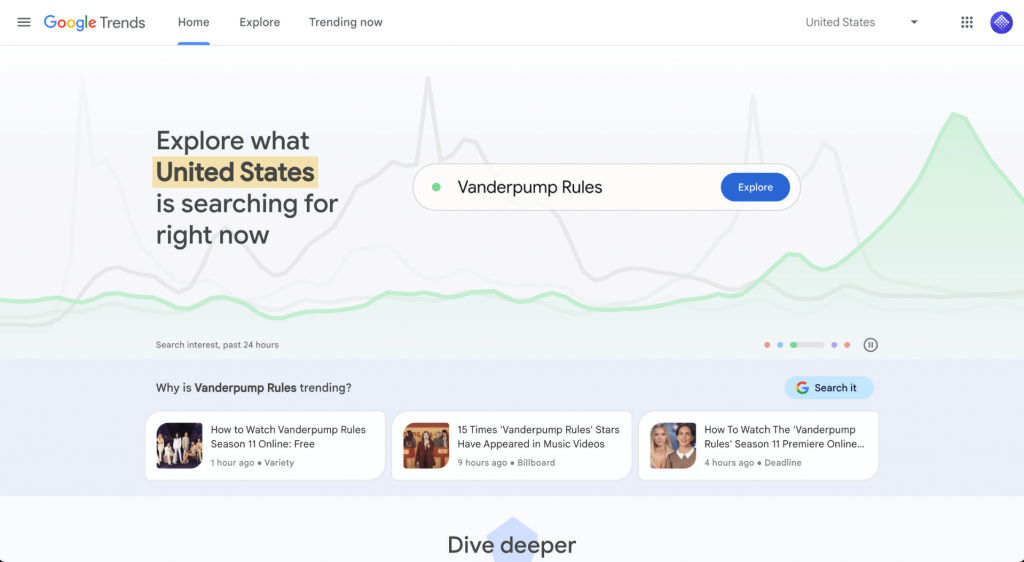
This website is a great starting point for trend research, as indicated by its name. This tool allows you to search for keywords and compare their overall popularity by location and interest over time. You can also explore related topics and search queries from Google. And the best part? It’s free to use!
This site is a paid function and is ideal for those who already have Google business accounts. While the site is originally for paid advertising on Google sites and searches, its super handy Keyword Planner tool is great for finding product and topic keywords that are viable. You’ll search for your niche item and any related keywords (just like SEO), and then compare their popularity. You’re looking for results that indicate above 10,000 searches per month for your main keyword, and 50,000 searches for other related keywords.
3. Trendhunter

With several different resources packed into one website, this tool is a great place to start when looking for inspiration. The “ideas” tab features a plethora of articles on wide-ranging topics and products, while the “insights” tab hosts a paid option to view metadata on consumer behaviors compiled by AI technology and crowd filtering. If nothing else, Trendhunter is worth an exploration if you’re feeling creatively blocked for niche ideas.
Deciding your niche
This final stage of the ideation process is the cherry on top it’s time to pick your perfect niche for your soon-tobe-bountiful Print on Demand business! At this point, the choice should be self-evident. You’ve brainstormed, you’ve researched and now you can pick the niche that is right in the middle of passion and profit.
You’ll need to double-check that your choice meets the criteria for a successful niche.
Is it specific enough? Does it have a clear customer base? Will it be easy to market? Can you realistically create a business around it? Is there a large enough product range that you can work off of? Do you have the skills/time/resources to build a business around this niche? Have you gotten outside feedback from friends or family about your idea?
Creating an ideal customer profile
One of the most important decisions you’ll make as a new business owner is deciding who you’re selling to. This is not only relevant for picking a niche or product line but also essential for making marketing decisions and strategizing for social media and SEO. Choosing a niche isn’t enough- you’ll also need to narrow that down to who exactly will be buying your items and visiting your store’s site.
Once you’ve chosen your audience, it will be much easier to pick specific products that are relevant and useful for your chosen demographic. While picking a market segmentation could be an 8-part article itself, we’re going to distill the concept into its most basic form.
Here’s what to consider when figuring out your ideal print-on-demand customer:
- Age range or generation
- Location
- Gender
- Race/Ethnicity
- Household income
- Education level
- Occupation
- Hobbies/Interests
- Lifestyle
- Personality
Now, combine all of these factors into a customer profile. For our example, we’ve chosen a product niche of wanderlust-inspired travel gear with map motifs and tropical designs. So, who would be interested in this product type? Here’s our estimation:
Our ideal customer: Millennial generation (18-35). North America/Australia/UK. Mostly female. White/Anglo-Saxon. Middle class. Some college education. Student or entry-level working professional. Interested in travel and adventure activities. Lives a healthy and adventurous lifestyle. Fun-loving.
Choosing your perfect niche products
Here’s some good news for you: the hardest part is over! Once you’ve narrowed down your niche and customer profile, the products will naturally fall in line. Please keep in mind as well that there will be quite a bit of trial and error involved in choosing your products. But that’s the benefit of a print-on-demand business- it’s at no cost to you to change your product listings over and over again as you are not stocking items in bulk. This means that it’s much easier to experiment with product types and designs in your store.
Let’s use our same niche example from above: wanderlust-inspired travel gear. Our product range features a map motif and tropical design and is for young travelers who are interested in expressing themselves through accessories and apparel items. Therefore, products such as tote bags, phone cases, t-shirts, beach towels, and bucket hats displaying the designs would work well.
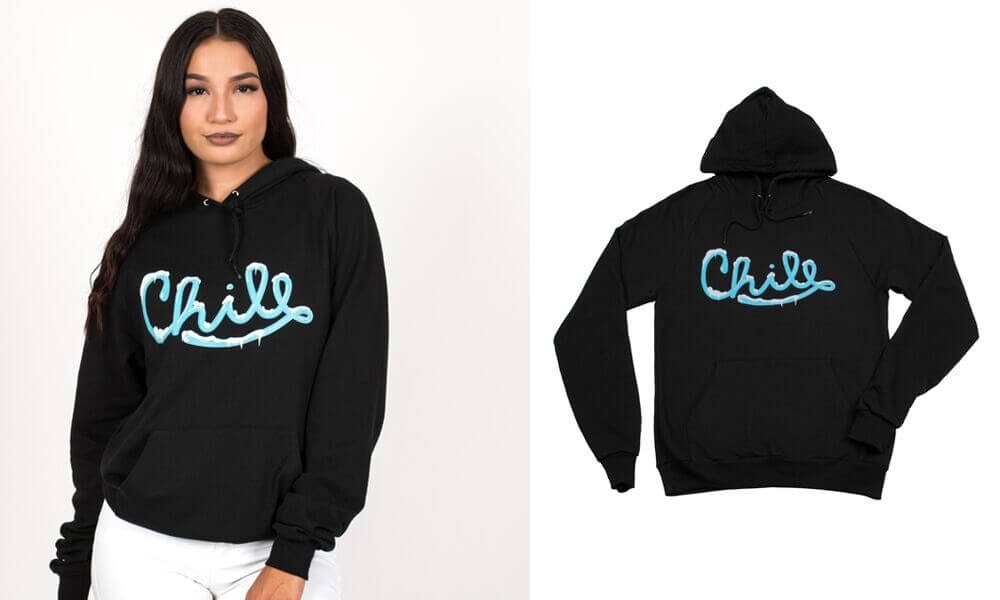
You can easily search Printful product catalogue and experiment with designs using their Mockup generator and product samples. Go ahead and explore the options until you find a decent range of products that meet your specific niche and shop specifications. Remember to start on the small side because you will be scaling your business as you grow your customer base. Also, you can launch new products as you figure out which products are successful and which are not (social media is also a great resource for crowdsourcing this type of information).
Confirming demand for your products
The best resource to use here for confirming demand is Amazon. You can take your product keywords and pop them into Amazon’s search bar. A basic review of the results will give you an indication of the number of competitors you’ll have, the popularity of the items, the starting price points, and other specific indicators. While you won’t necessarily be using Amazon to host your shop (we highly recommend using Shopify), it’s still a great way to scope out your online competition as Amazon is a widely popular starting point for shoppers in North America and abroad. Similarly, if you’re located elsewhere, you can use your region’s version of Amazon (ex: Alibaba Express).
Learn more: Best Print on Demand Apps For Your Online Store: A Complete Review
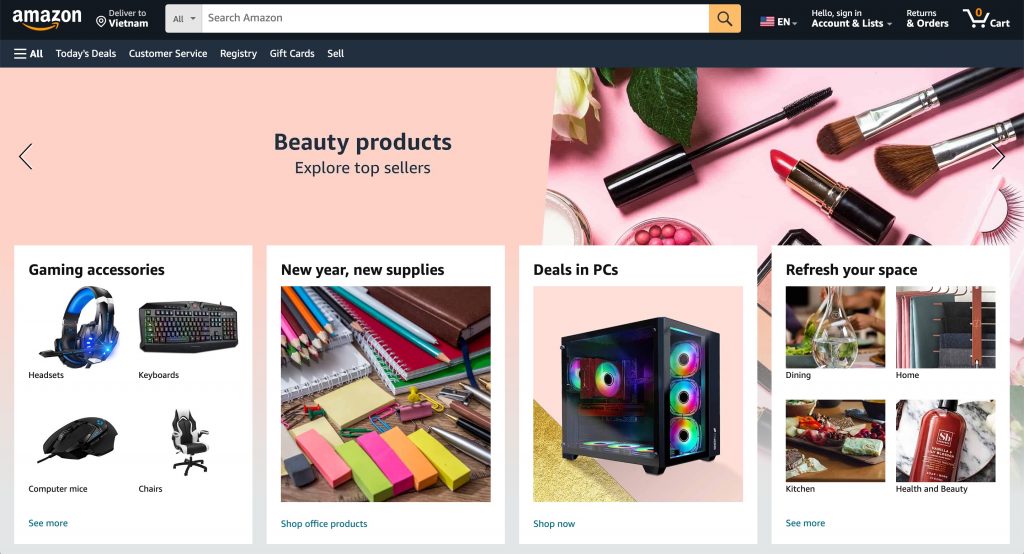
Case studies: How to stand out
These 2 successful print-on-demand companies have some great advice on how to differentiate yourself from your competitors.
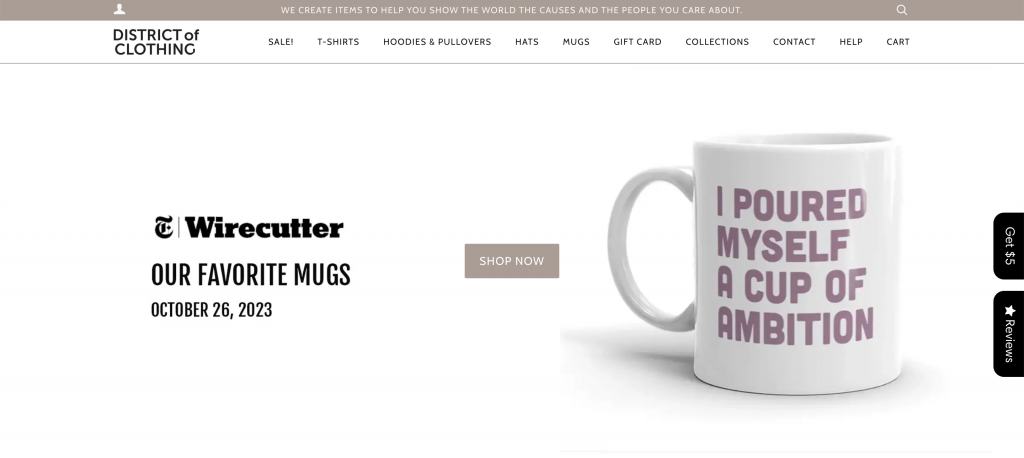
What: Apparel with inspiring messages
How they set themselves apart: Storytelling. By leveraging authenticity they indicate to their customers that they are unique. They utilize social media avenues such as Instagram to feature real customers wearing their products with tags and comments. This positions them as an entire “lifestyle brand” and more than just another clothing company.
See the full article on Printful’s blog.

What: Posters and mugs featuring designs inspired by ski slope trail maps
How they set themselves apart: Brand platforms. They avoided using brand marketplaces such as Zazzle, Redbubble and Society6 because of the competition and low-profit margins. Because the sites show customers other related products from different brands, it takes customers away from their products and onto a competitor’s page. By avoiding these websites they can control their audience’s shopping experience.
For more case studies, check out: Top 15+ Shopify T-Shirt Stores You Can Learn From.
Launch your new POD business with Shopify
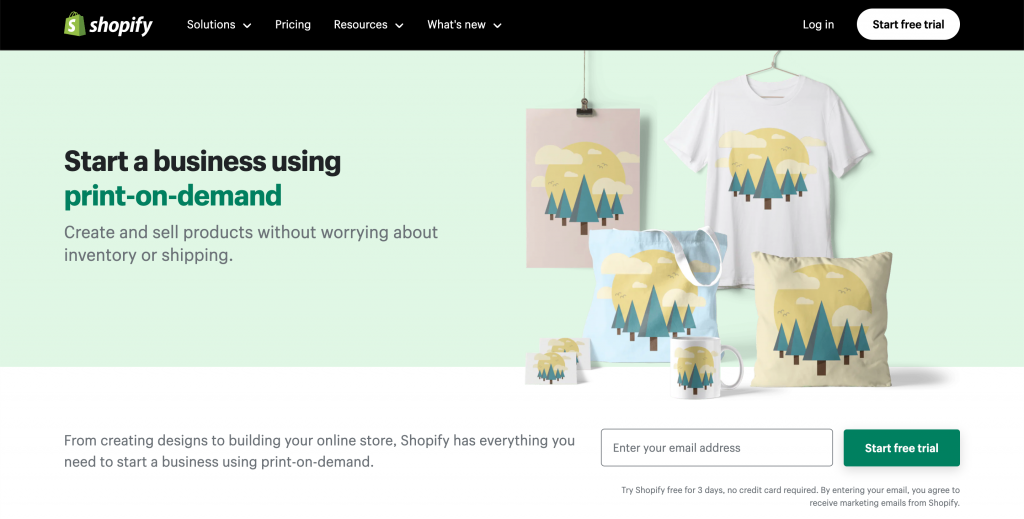
Now that you’ve done your homework, you’re ready to get to business.
Deciding on Product Niches, that’s the very first baby step toward a Print on Demand success. Next, you need to get a store up and running.
However, it’s important to keep in mind that it may take a month or so to see any real sales so stay patient – good things take time.
Open Shopify Store with a 3-Day Free Trial
Over 1,700,000 businesses in 175 countries around the world have made over $200 billion USD in sales using Shopify.
